Now Playing: Haibane Renmei
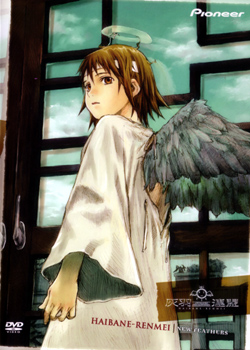
Haibane Renmei
A girl falls from the sky. A crow swoops by to caw at her and tug the hem of her dress, as though trying to pull her back into the clouds. She shakes her head, but thanks the bird as it flies away. The winds shake her, and an expanse of town and countryside appears below. With a shriek, she’s torn from the view. So begins Haibane Renmei.
The girl awakens inside a large plantlike cocoon that fills a storeroom of an old and semi-dilapidated dormitory, just outside of the town she glimpsed before. Her chrysalis is soon found by the building’s residents, children and young women with halos above their heads and small, seemingly useless gray wings on their backs. Named for these ashen feathers, they are the Haibane, and the cocoon contains the newest of their family.
Despite the comforting aura of the aged building, aptly named Old Home, and warm introductions to her fellow Haibane, the girl is worried upon emerging. She lacks any memory of who she is or where she came from, remembering only her vision of falling. The other Haibane explain that this is normal, and that her dream suggests her new name: Rakka, for “fall.” In time, Rakka overcomes her trepidations and gets to know the rest of the Haibane, including pushy tomboy Kana, sedate librarian Nemu, perpetually pleasant sneak Hikari, and carefree runt Kuu.
Yet it’s a thoughtful, chain-smoking, raven-haired Haibane named Reki who grows closest to Rakka, helps her deal with the painful emergence of her wings (in a scene both gruesome and beautiful), and introduces her to her new life. Under the orders of masked monks known as the Haibane Renmei (or the “Charcoal Feather Federation”), the ash-winged Haibane are allowed only second-hand clothes, limited in the jobs they can take, and forbidden to possess any money. Most importantly of all, both the Haibane and the normal residents of the nearby town of Glie are barred from going beyond a massive wall that surrounds the town, Old Home, and the nearby hills. The only ones who cross this imposing boundary are a group of silent traders and, Rakka notes with interest, the birds.
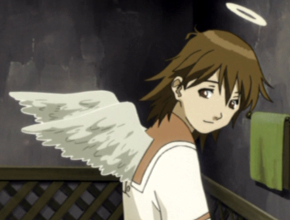 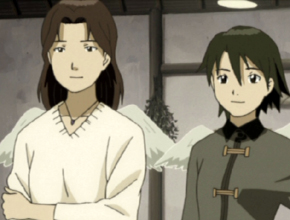 |
Though Yoshitoshi ABe contributed character concepts and more to the marvelously postmodern Serial Experiments Lain and the laid-back comedy NieA_7, Haibane Renmei is the first series to be his from the start, as he not only created the doujinshi (an underground comic, in other words) upon which it was based, but also scripted all of the episodes and storyboarded most of them. For a presumed novice, ABe has done surprisingly well. He and director Tomokazu Tokoro choose a languid pace slightly reminiscent of Niea, yet Haibane Renmei proves more complicated, using clever lighting and brushed-aside comments to hint at darker elements beneath the pleasantness of Rakka’s day-to-day life. On its surface, though Haibane Renmei’s world is gorgeous. The backdrops of Old Home and the town of Glie are placid and comforting, with the nostalgic allure of some quaint corner of Europe, perhaps the same vicinity that Miyazaki visited in Kiki’s Delivery Service and Castle in the Sky.
It’s a scenario that ABe borrowed wholeheartedly from Haruki Murakami’s novel Hard-Boiled Wonderland and the End of the World, which spent half its time following an amnesiac narrator’s attempts to escape a laid-back pastoral purgatory. Haibane is more hopeful in its outlook, but it’s just as intriguing. The series slowly builds ominous tones in the world around Rakka and Reki, subtly revealing the harsh truth of the Haibane. And unlike other shows that focus on personal trauma, the story never strays too far. It’s cute without being saccharine. It’s subdued without leaving one lost in nuances. It’s simple without scraping banality. And when it reaches an emotional peak, it’s powerful without reeking of angst.
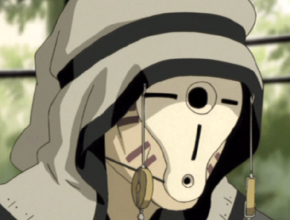
Haibane Renmei owes some of its pull to Ko Otani’s superb psuedo-classical soundtrack, and an ending theme, performed by Heart of Air, that fits perfectly. The voice acting is also impressive, and surprisingly equal in quality between the Japanese and English casts. Carrie Savage (Peppo in Gankutsuou) plays Rakka with a frailty and resolve equal to Ryo Hirohashi’s performance, Erika Weinstein handles Reki’s moods much like Junko Noda does, and only the most peripheral dub roles have awkward tones. While New Generation Pictures’ dub work didn’t impress me at first, this one seems their best yet.
Some might not warm to Haibane Renmei’s slow-burning storyline, since it offers little in the way of epic melodrama, rapid-fire violence, or giant robots. Yet that’s part of the charm, I think. By making a show with little regard for commercial appeal, ABe and Tokoro have created something of uncommon value. Haibane Renmei is often as vague as the mysteries it bears, but it’s no less a wonderful tale.
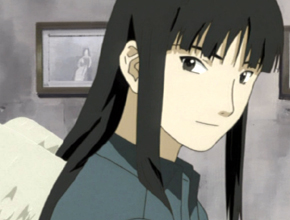
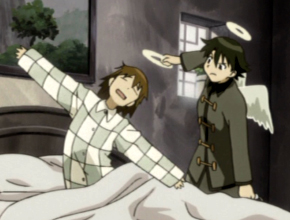







 Kasumi Tomine
Kasumi Tomine  Yuri Otani
Yuri Otani  Kumi Kawamura
Kumi Kawamura 

